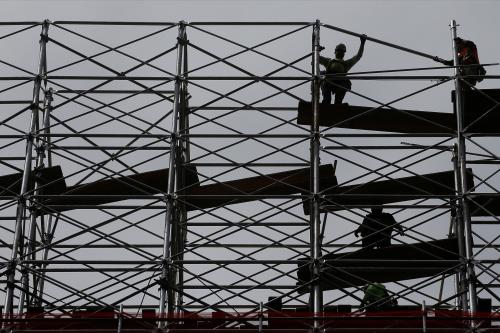The Bureau of Labor Statistics (BLS) employment report released today shows that 33,000 jobs were lost in September. In this blog post, I report results from three alternative projections, each of which was calculated using methodology outlined in my past research. However, it is important to note that these methods do not take into account the effects of hurricanes Harvey and Irma, which are clearly the dominant factors affecting today’s jobs numbers. Accordingly, I begin with a discussion of their likely effect. Incorporating this effect into the standard weather adjustment yields 74,000 jobs added in September. The bottom line is that it is a weak jobs report, but the weakness is exaggerated by the effect of the hurricanes.
Hurricane Effects
Hurricane Harvey made landfall in Texas on August 25, and proceeded to flood the city of Houston—America’s 4th largest city—for the next several days. However, because data for the August establishment survey were largely collected before the storm, Harvey had no material effect on August’s employment numbers, but did affect employment for September. Hurricane Irma made landfall in Florida on September 10, which is right around the time of the September establishment survey. Preliminary damage estimates are around $100 billion for Hurricane Harvey and $65 billion for Hurricane Irma, which together puts the damage on par with Hurricane Katrina in 2005.
In my 2015 paper “Weather-Adjusting Economic Data” with Michael Boldin, we experimented with including damage from hurricanes as a weather variable. But working with national data, we found it difficult to estimate the effect with reasonable precision; it seems essential to use data at the state and local levels to estimate the employment effects of hurricanes. Thus, we did not include a hurricane factor in our preferred empirical specification.
The bottom line is that it is a weak jobs report, but the weakness is exaggerated by the effect of the hurricanes.
State and local employment estimates for September will not be available until October 20. We do, however, have state-level data for initial jobless claims, which spiked by about 70,000 in Texas and Florida combined. Initial jobless claims have been a reasonable indicator of employment losses for past hurricanes, although it is important to remember that undocumented immigrants can be included in the establishment survey, but cannot claim unemployment insurance.
Preliminary estimates by the Federal Reserve Bank of Dallas suggest that Harvey could result in a decline in Texas payrolls of around 40,000 in September, rather an increase of around 30,000 jobs that was otherwise predicted—a 70,000 effect for Texas alone. Employment in Louisiana fell by over 100,000 in the wake of Hurricane Katrina in September 2005, which has resulted in about the same damage as hurricanes Harvey and Irma combined. Taking all this into account, a reasonable estimate of the combined effect of hurricanes Harvey and Irma on September’s employment data is roughly –100,000 jobs, which swamps the typical seasonal and weather effects. Adjusting the BLS Official number with this estimated hurricane effect yields an underlying pace of jobs growth of 67,000. But we will get a better read on this when the state-level jobs numbers are released in two weeks.
Two final points about the effects of hurricanes on employment numbers must be made. The first is that hurricanes disrupt the physical technology used to collecting the employment data. As a result, future data revisions may be larger than usual. Second is that employment is be expected to bounce back as the hurricane cleanup process gets underway, and so we should expect a positive bump for October and November’s jobs data.
I return now to discussion of the Alternative Seasonal Adjustment and Seasonal and Weather Adjustment, the latter of which only controls for unusual temperature and snowfall.
Calculating the Alternative Seasonal Adjustment
Monthly job gains and losses can indicate how the economy is doing once they are corrected to account for the pattern the BLS already expects in a process called seasonal adjustment. The approach for this seasonal adjustment that is presently used by the BLS puts very heavy weight on the current and last two years of data in assessing what are the typical patterns for each month.
In my 2013 paper “Unseasonal Seasonals?” I argue that a longer window should be used to estimate seasonal effects. I find that using a different seasonal filter, known as the 3×9 filter, produces better results and more accurate forecasts by emphasizing more years of data. The 3×9 filter spreads weight over the most recent six years in estimating seasonal patterns, which makes them more stable over time than the current BLS seasonal adjustment method.
To produce the Alternative Seasonal Adjustment, I calculate the month-over-month change in total nonfarm payrolls, seasonally adjusted by the 3×9 filter, for the most recent month, which you can see in table below. The corresponding data as published by the BLS are shown for comparison purposes. According to the Alternative Seasonal Adjustment, the economy lost 45,000 jobs in September, 12,000 more than the official BLS total of 33,000 jobs lost.
Calculating the Seasonal and Weather Adjustment
In addition to seasonal effects, abnormal weather can also affect month-to-month fluctuations in job growth. In my 2015 paper “Weather-Adjusting Economic Data” with Michael Boldin, we implement a statistical methodology for adjusting employment data for the effects of deviations in weather from seasonal norms. This is distinct from seasonal adjustment, which only controls for the normal variation in weather across the year. We use several indicators of weather, including temperature and snowfall. But, as described above, this adjustment does not include the effects of hurricanes. The Seasonal and Weather Adjustment estimate for September is 26,000 fewer jobs. Adjusting by the hurricane effect estimate brings us to an underlying pace of employment growth of around 74,000 jobs. This suggests a slowdown in the pace of hiring that is however compounded by the hurricane effect in this morning’s data.
| Thousands of jobs added | BLS Official | Alternative Seasonal Adjustment[1] | Seasonal and Weather Adjustment[2] | Weather Effect[3] |
|---|---|---|---|---|
| 2017-September | -33 | -45 | -26 | -7 |
| 2017-August | 169 | 170 | 179 | -10 |
| 2017-July | 138 | 159 | 120 | +18 |
| 2017-June | 210 | 226 | 213 | -3 |
| 2017-May | 145 | 136 | 160 | -15 |
| 2017-April | 207 | 205 | 171 | +36 |
| 2017-March | 50 | 30 | 112 | -62 |
| 2017-February | 232 | 256 | 207 | +25 |
| 2017-January | 216 | 199 | 197 | +19 |
| 2016-December | 155 | 154 | 158 | -3 |
| 2016-November | 164 | 180 | 183 | -19 |
| 2016-October | 124 | 122 | 113 | +11 |
| 2016-September | 249 | 243 | 251 | -2 |
Note: Changes in previous months’ numbers reflect revisions to the underlying data.
[1] Applies a longer window estimate of seasonal effects (see Wright 2013).
[2] Includes seasonal and weather adjustments, where seasonal adjustments are estimated using the BLS window specifications (see Boldin & Wright 2015).
[3] BLS Official number less the Seasonal and Weather Adjustment number.
The author did not receive financial support from any firm or person for this article or from any firm or person with a financial or political interest in this article. He is currently not an officer, director, or board member of any organization with an interest in this article.
The Brookings Institution is committed to quality, independence, and impact.
We are supported by a diverse array of funders. In line with our values and policies, each Brookings publication represents the sole views of its author(s).






Commentary
Jobs numbers feel the effects of hurricanes Harvey and Irma
October 6, 2017